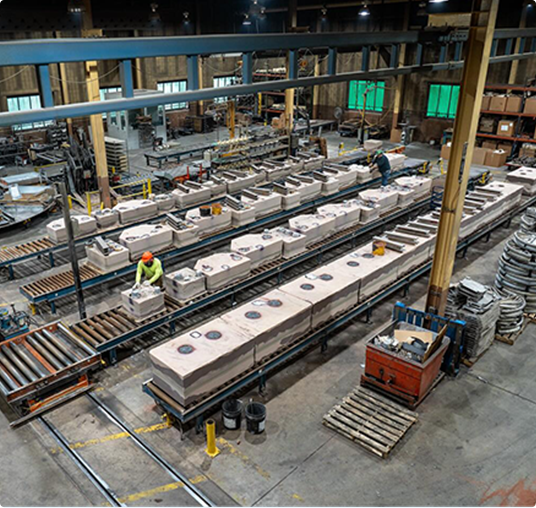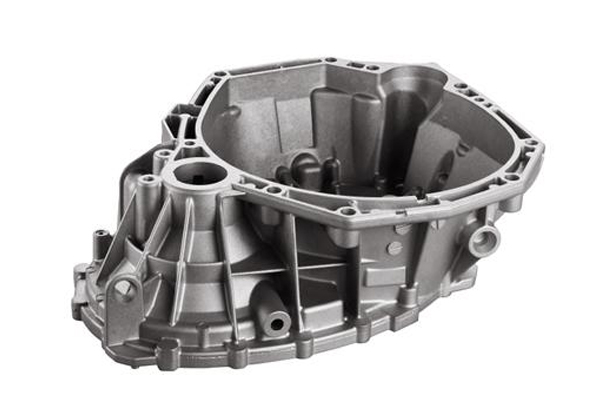Aluminum Castings and green innovation: What’s new?
Exploring the Conveniences and Techniques of Aluminum Casting in Modern Manufacturing
Aluminum casting has actually arised as a pivotal strategy in modern-day manufacturing. Its light-weight residential or commercial properties boost energy effectiveness and lower transport costs. Additionally, advancements in casting techniques make it possible for complex styles and quick prototyping. The advantages extend past simple effectiveness - Aluminum Castings. The sustainability of aluminum casting processes provides significant effects for numerous industries. Understanding these elements can disclose the transformative impact of aluminum in contemporary production practices. What more innovations could redefine its function?
The Lightweight Benefit of Aluminum Casting
Aluminum casting supplies a substantial lightweight benefit that is changing markets reliant on long lasting yet workable products. This property is especially useful in markets such as automobile and aerospace, where every ounce counts in efficiency and fuel performance. The lowered weight of aluminum elements permits improved handling, reduced transport costs, and boosted power efficiency throughout procedure. Unlike much heavier steels, aluminum gives a balance of strength and agility, making it an excellent option for complex applications that demand high efficiency without compromising structural honesty. Furthermore, the rust resistance of aluminum expands the life expectancy of cast parts, lowering the requirement for frequent replacements. This mix of lightweight characteristics and longevity settings aluminum casting as a vital modern technology in contemporary production processes, urging advancement and supporting the growth of advanced items that meet the progressing demands of different industries.
Improved Layout Versatility and Intricacy
Design adaptability and complexity are markedly enhanced via making use of aluminum casting, enabling suppliers to develop elaborate shapes and types that were formerly unattainable with conventional approaches. This capability allows the manufacturing of parts with comprehensive geometries, such as intricate inner passages and thin-walled structures, which can significantly boost the performance of the final product.
In addition, aluminum casting techniques, such as die casting and sand casting, assist in quick prototyping, enabling designers to repeat and improve their principles swiftly. The capability to create personalized mold and mildews likewise adds to far better placement with specific design requirements, decreasing material waste and lessening the demand for extensive machining.
Additionally, the lightweight nature of aluminum complements its style versatility, as it permits both visual allure and functional effectiveness. On the whole, the advancements in aluminum casting supply suppliers with the tools to push the borders of layout, cultivating development across various markets.

Superior Thermal and Electrical Conductivity
Aluminum's premium thermal and electrical conductivity makes it a necessary material in different manufacturing applications. Compared to other metals, aluminum provides considerable benefits, especially in warmth dissipation and electric performance. Aluminum Castings. This residential or commercial property enables its extensive use in markets ranging from automobile to electronics, enhancing overall performance and reliability
Thermal Conductivity Advantages
A key benefit of aluminum casting hinges on its premium thermal and electric conductivity, making it an ideal choice for various applications in modern-day production. The high thermal conductivity of aluminum permits effective warm dissipation, which is important in industries such as automotive and electronic devices. Elements crafted from aluminum can successfully handle temperature fluctuations, prolonging the life-span of items and improving performance. This attribute also makes it possible for suppliers to produce light-weight styles without compromising thermal performance. In addition, aluminum's capability to withstand thermal biking additionally solidifies its placement in requiring atmospheres. As industries increasingly focus on energy efficiency and efficiency, the thermal conductivity advantages of aluminum casting become significantly considerable in driving development and sustainability.
Electrical Conductivity Applications
The electric conductivity of aluminum matches its thermal properties, making it a valuable product in different applications within modern production. This conductivity allows reliable power transfer, which is vital in electric parts such as electrical wiring, adapters, and circuit boards. Aluminum's lightweight nature better improves its allure in applications where lowering weight is essential, such as in aerospace and auto markets. In addition, aluminum casting allows for the production of intricate shapes, maximizing the performance of electrical tools. The material's resistance to rust and oxidation additionally adds to long life in electrical settings, guaranteeing dependability. On the whole, aluminum's exceptional electric conductivity placements it as a recommended choice in markets that require high efficiency and performance in their electrical applications.
Comparison With Other Metals
While aluminum is renowned for its premium thermal and electrical conductivity, it is vital to contrast its residential properties with those of various other steels to understand its advantages fully. Copper, as an example, shows also higher electrical conductivity, making it more effective in specific applications like electrical wiring. Nonetheless, copper's weight and cost can restrict its usage. On the other hand, aluminum uses a desirable balance of conductivity, weight, and affordability, making it excellent for lots of production applications. Furthermore, aluminum's thermal conductivity is typically remarkable to that original site of stainless-steel and titanium, which are often utilized in high-temperature environments. Ultimately, aluminum stands out not only for its conductivity yet also for its lightweight and corrosion-resistant residential properties, making it a functional option in contemporary manufacturing.
Cost-Effectiveness and Reduced Product Waste
Taking full advantage of cost-effectiveness and reducing material waste are essential benefits of aluminum casting in contemporary manufacturing. Aluminum's lightweight nature adds to decrease delivery expenses and power usage during production. In addition, its superb recyclability suggests that scrap product produced during the casting procedure can be reused, significantly reducing the total material costs.
Moreover, aluminum casting methods typically allow for intricate shapes to be generated with less second procedures, which simplifies the manufacturing process and reduces labor expenses. The capacity to create precise parts minimizes the demand for extreme machining, further minimizing waste.
Companies adopting aluminum casting advantage from decreased manufacturing time and increased effectiveness, leading to general price savings. This mix of lower material expenses, reliable recycling techniques, and reliable production procedures placements aluminum casting as an economically advantageous option in the affordable landscape of contemporary manufacturing.
Advancements in Aluminum Casting Techniques
Current improvements in aluminum casting methods are changing the production landscape. Innovations such as the integration of additive manufacturing, improved mold and mildew layouts, and environment-friendly casting procedures are driving performance and sustainability. These developments not just improve product quality however likewise minimize ecological influence in the aluminum casting sector.
Additive Production Assimilation
Additive production is changing aluminum casting strategies by enabling the manufacturing of intricate geometries and lightweight structures that were previously unattainable. This combination enables suppliers to utilize 3D printing technologies to produce complex molds and cores, which assist in the casting of in-depth styles with improved precision. In addition, additive production minimizes material waste and shortens lead times, making it a more lasting and reliable strategy. As a result, companies can respond more rapidly to market needs and tailor items to satisfy particular customer requirements. This harmony in between additive production and aluminum casting not only enhances design flexibility but likewise positions suppliers to introduce continually, driving innovations in performance and item efficiency within the affordable landscape of contemporary production.

Enhanced Mold Layout
As producers seek to boost effectiveness and item high quality, developments in mold and mildew style have become a vital consider modern-day aluminum casting methods. Advanced mold products, such as silicon carbide and graphite, enhance thermal conductivity and longevity, enabling for faster air conditioning and enhanced surface area finishes. Furthermore, the combination of computer-aided design (CAD) innovation enables specific mold geometries, facilitating complicated shapes that were formerly challenging to attain. Advancements like 3D-printed molds likewise offer quick prototyping capabilities, reducing preparations significantly. Additionally, modular mold and mildew styles allow for less complicated modifications and repairs, decreasing downtime during manufacturing. Jointly, these enhancements not just enhance making procedures yet additionally contribute to the general top quality of aluminum cast products, satisfying the evolving demands of different sectors.
Eco-Friendly Casting Processes
While the aluminum casting sector remains to progress, a growing focus on sustainability has actually resulted in the development of environmentally friendly casting procedures. These cutting-edge methods aim to reduce environmental impact by reducing waste and energy consumption. One noteworthy method includes utilizing recycled aluminum, which significantly decreases the carbon impact connected with resources removal. In addition, innovations in mold and mildew products and styles enable for much more efficient heat transfer, reducing power needs throughout production. Water-based try this website finishes and binders change conventional solvents, furthermore decreasing hazardous emissions. Some suppliers are embracing closed-loop systems, guaranteeing that waste materials are recycled within the manufacturing cycle. Collectively, these environmentally friendly casting processes not only enhance sustainability but additionally add to an extra liable production landscape.
Sustainability in Aluminum Casting Processes
Sustainability in aluminum casting processes has actually ended up being a centerpiece for suppliers aiming to reduce their environmental effect. The industry is increasingly embracing methods that minimize waste and boost resource performance. One significant strategy includes the usage of recycled aluminum, which needs just a fraction of the power needed to generate new steel from ore. This not only conserves sources but additionally minimizes greenhouse gas emissions connected with manufacturing.
Advancements in innovation have actually led to even more energy-efficient casting methods, such as low-pressure and gravity casting, which enhance product usage and decrease energy intake. Aluminum Castings. Producers are likewise carrying out closed-loop systems that enable the recycling of scrap product generated during the casting process. Additionally, using eco-friendly finishings and lubricants even more adds to an extra lasting procedure. Overall, these initiatives show a commitment to ecological stewardship while preserving the top quality and performance of aluminum casting
Applications of Aluminum Casting Throughout Industries
Aluminum casting finds comprehensive applications across numerous sectors due to its lightweight, stamina, and adaptability. In the auto sector, aluminum castings are utilized to generate engine blocks, transmission real estates, and wheels, boosting gas performance while lowering exhausts. The aerospace sector makes use of aluminum spreadings for architectural parts, taking advantage of their high strength-to-weight proportion, which is essential for trip safety and security and efficiency.
In the customer electronics industry, aluminum castings are used for housing and structural components, offering toughness and visual charm. Furthermore, the building industry leverages aluminum castings for architectural components and components, maximizing their resistance to deterioration.
In addition, the aquatic browse around this web-site sector integrates aluminum castings in boat frames and engine components, reflecting its viability for harsh settings. In general, the diverse applications of aluminum casting highlight its importance in modern production, adding to technology and effectiveness throughout different areas.
Regularly Asked Questions
What Are the Common Alloys Made Use Of in Aluminum Casting?
The typical alloys made use of in aluminum casting include 413, 356, and A380. These alloys are valued for their superb fluidness, strength, and corrosion resistance, making them ideal for numerous applications in manufacturing and design.
How Does Aluminum Casting Contrast to Various Other Casting Techniques?
Aluminum casting deals distinct benefits over various other casting methods, such as lighter weight, superb rust resistance, and premium thermal conductivity. It also permits elaborate layouts and faster production times compared to typical materials like iron or steel.
What Is the Regular Life Expectancy of Aluminum Cast Products?
The regular life expectancy of aluminum actors products differs, generally varying from 20 to 50 years, depending on factors such as ecological problems, maintenance, and specific applications. Proper treatment can significantly prolong their sturdiness and efficiency.
Are There Any Kind Of Wellness Risks Related To Aluminum Casting?
The concern of wellness threats related to aluminum casting emerges due to prospective direct exposure to aluminum dust and fumes. Prolonged inhalation might result in respiratory problems, highlighting the value of suitable precaution throughout the casting procedure.
Exactly How Can Issues Be Decreased in Aluminum Casting?
To decrease issues in aluminum casting, suppliers can apply rigorous top quality control actions, maximize mold and mildew styles, keep proper temperature control, make use of ideal alloy make-ups, and use efficient cleaning techniques to assure a defect-free casting procedure.